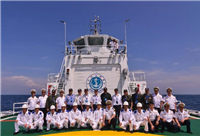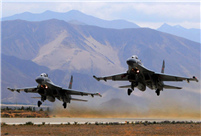

An undated photo shows a solar powered UAV (Unmanned Aerial Vehicle), designed by China Academy of Aerospace Aerodynamics, flies during a test. The UAV, with a wingspan of more than 40 meters, is a long-endurance, high-altitude aircraft system that has a broad application prospect. The solar powered aircraft Solar Impulse II landed in western India on Tuesday night, completing the second leg of its historic round-the-world trip. The Solar Impulse II also plans to make stops in China. (Photo/people.cn)
The Swiss solar-powered plane Solar Impulse 2 (Si2) took off from the UAE Monday, starting its five-month record-breaking round-the-world flight. In due course the plane will touch down in Chongqing and Nanjing.
The Si2 is powered by 17,247 solar cells stretched across the plane's wings which exceed the span of a Boeing 747. Lithium batteries will help store energy, allowing the aircraft to fly at night.
China is well to the fore in this field. The China Academy of Aerospace Aerodynamics has been quick to achieve fruitful results in height gain and endurance of its solar-powered UAV.
Developed by China Academy of Aerospace Aerodynamics, China’s own solar UAV is the world's largest unmanned solar aircraft, with a wingspan of more than 40 meters and a lightweight structure with large aspect ratio.
Traditional aircraft using chemical fuel cause severe pollution to the atmosphere. The solar-powered UAV, a real green and environmental-friendly aircraft, has prospects for extensive applications.
 |
 Beijing's toughest anti-smoking law takes effect
Beijing's toughest anti-smoking law takes effect Attendants-to-be join Mr. & Miss Campus Contest
Attendants-to-be join Mr. & Miss Campus Contest China hosts overseas disaster relief exercise for the first time
China hosts overseas disaster relief exercise for the first time J-11 fighters in air exercise
J-11 fighters in air exercise Beauties dancing on the rings
Beauties dancing on the rings PLA soldiers operating vehicle-mounted guns in drill
PLA soldiers operating vehicle-mounted guns in drill 20 pairs of twins who will become flight attendants in Sichuan
20 pairs of twins who will become flight attendants in Sichuan Blind carpenter in E China's Jiangxi
Blind carpenter in E China's Jiangxi Top 10 highest-paid sports teams in the world
Top 10 highest-paid sports teams in the world Obama is sowing discontent in S.China Sea
Obama is sowing discontent in S.China Sea Rescuers work through night to reach cruise ship survivors
Rescuers work through night to reach cruise ship survivors Driving through limbo
Driving through limbo Facing down MERS
Facing down MERSDay|Week